Once you have created the
Sample Type, you can create the samples themselves in several ways. Import an existing inventory spreadsheet, create the samples individually, or enter information in bulk (and then refine it). The Sample Type acts like a table and each individual sample of that type will be a row in the table.
For a tutorial walkthrough of adding samples to the system, see this topic:
Tutorial: Add Samples
Note: Once you have added some samples, you can select one or more before clicking
Create and then create new derivatives, pooled samples, or aliquots from them. Learn about these options in the topic:
Aliquots, Derivatives, and Sample Pooling.
Choose Desired Sample Type and Import Method
To create new samples, you specify the type of sample you are creating. Most
Create menus give you a
Samples option where you can choose the type of sample to create by selecting
Create > [Sample Type].
- The most general method is to go to the home page dashboard and click Create Samples. (On narrow browser windows you may need to scroll down to find the Dashboard Insights panel.)
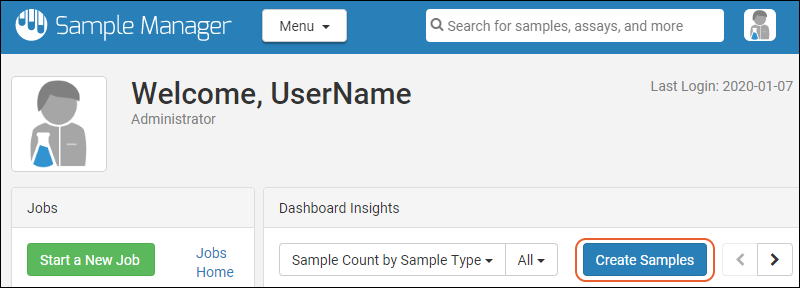
- Click the tab for your import method:
- Select the Sample Type you are creating using the dropdown. You can type ahead in the box to narrow the selections when the list is long.
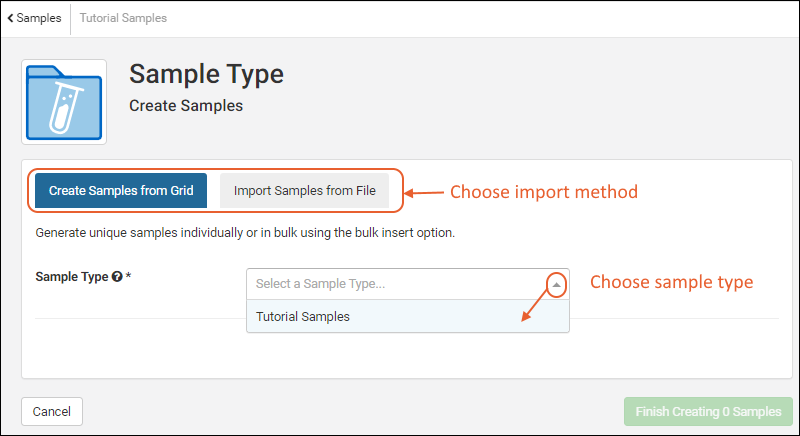
You will now be creating samples of that type and the creation interface will reflect your method.
Create Samples From Grid
Using the
Create Samples From Grid tab gives you several options for entering sample information in the application directly, as opposed to uploading a file of data. You can manually enter values for the fields in a grid format, or use bulk insert and bulk update to streamline entry of similar values.
Note that fields of type
File are not included in grid import methods. Values must be individually added as described in this topic:
Attach Images and Other Files.
Add Parent (Optional)
If the samples you are adding have one or more
Parent samples, click
Add Parent to add parentage information. Select the Sample Type of the parent(s). If you will have parents of different types, add one for each type of parent.
Learn more about including parentage information in this topic: Sample Lineage / Parentage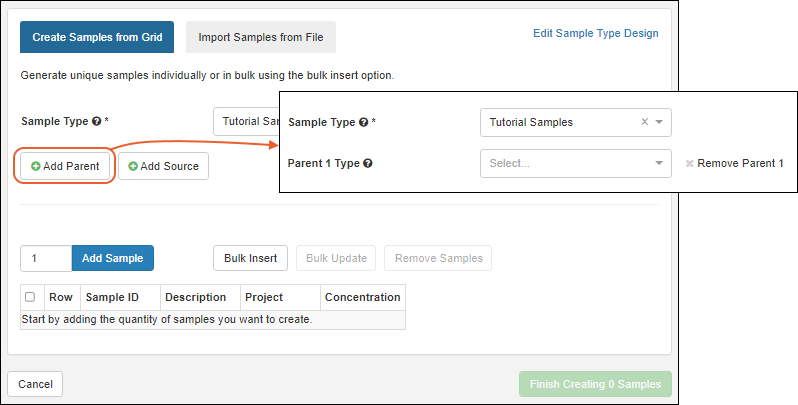
If you add but then want to remove parent linkages, you can delete it by clicking the X next to "Remove Parent #" on the right.
Add Source (Optional)
If the samples you are adding have one or more
Sources, click
Add Source to add a column for each Source Type you will associate with samples of this type. Select the Source Type from the dropdown.
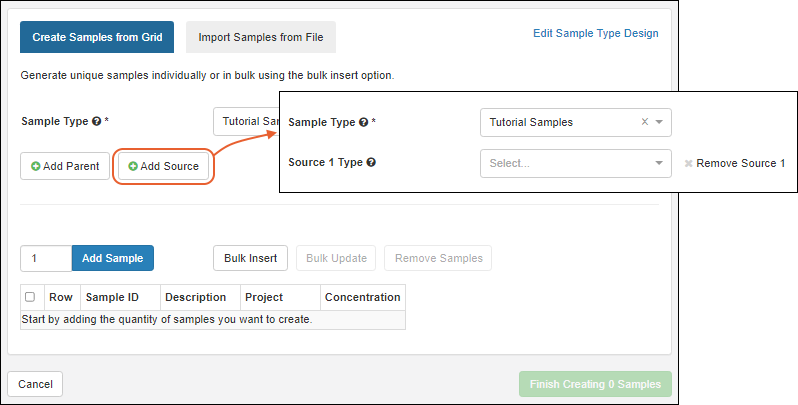
If you add but then want to remove source linkages, you can delete it by clicking the X next to "Remove Source #" on the right.
Add Samples Individually
To directly create samples in a grid, start by adding a blank row for the samples you want to create. Enter the number of samples you want to add and click
Add Samples.
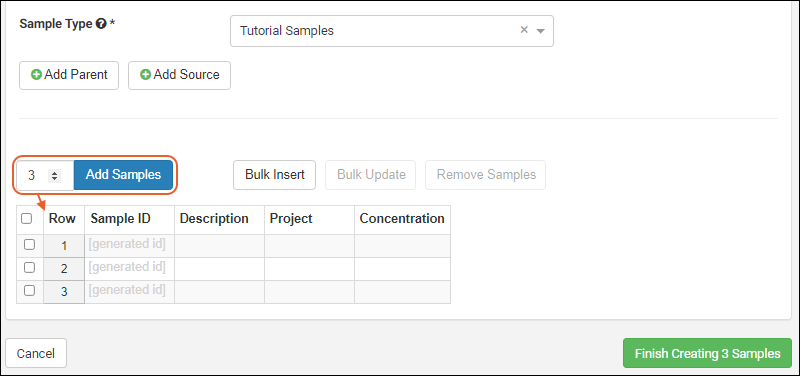
A grid with the requested number of rows will be created, with a column for each field included in your Sample Type (
not including any "File" fields).
- Sample ID:
- If you provided a Naming Pattern with the Sample Type, the Sample ID will be generated, and this will be noted in the grid. You could override this value by manually typing in the box, but remember that all sample IDs must be unique.
- If you are providing your own Sample ID, you will a column in which to enter it.
- Enter values for remaining fields as well.
- Shown below, an ID will be generated and there are fields populated for "Description" and "Project":

Enter your data directly into the grid. Copy and paste of single cells is supported. When ready, click
Finish Creating # Samples. The number you are creating will appear on the button.
You will see the sample grid for that type, with a banner message indicating how many were created. In that message, click
select them in the grid to select this recently created batch for actions like adding them to a workflow job. You can also click
Add them to storage to immediately
add the new samples to freezer storage locations.
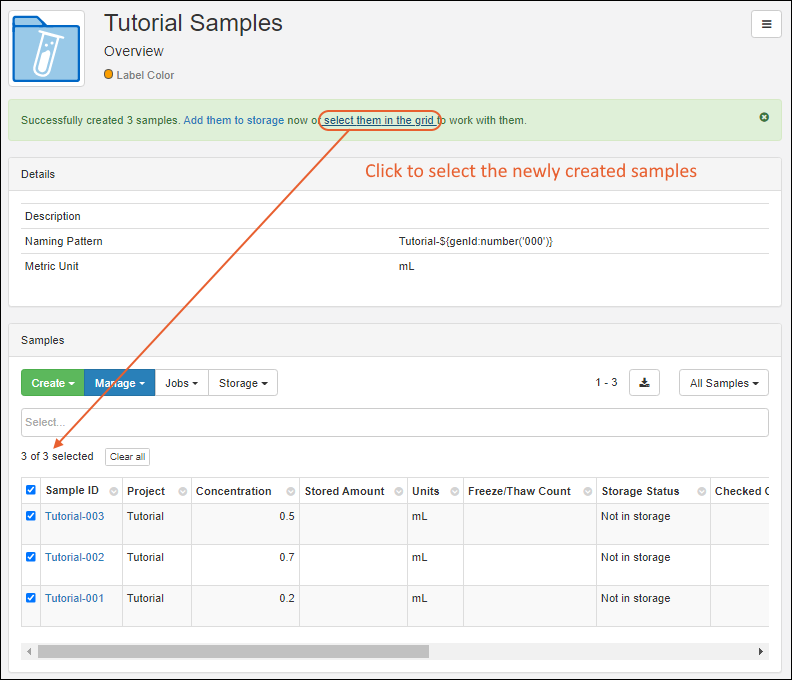
Reopen to add more samples by selecting
Create > [Sample Type].
Bulk Insert
Instead of directly populating a grid, you can click
Bulk Insert to create many samples at once. This is particularly convenient when samples share the same settings for some or all columns.
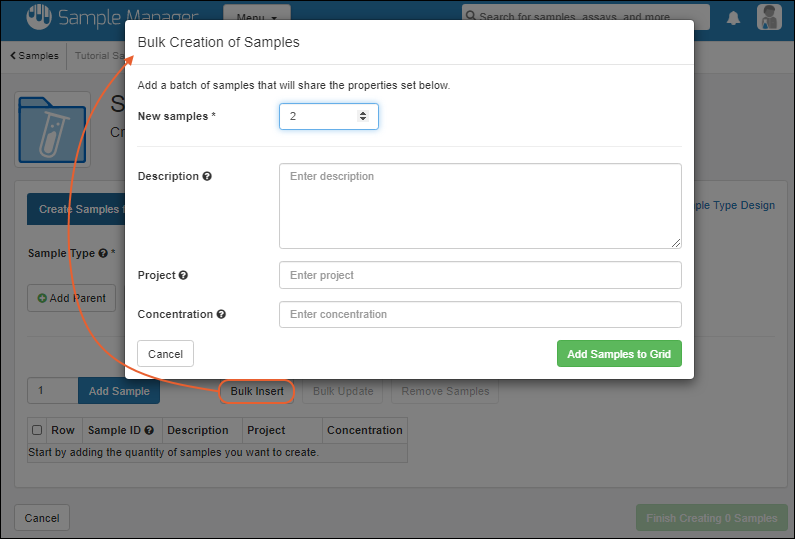
- Specify the number of New Samples.
- Enter values for any or all of the properties listed.
- Click Add Samples To Grid.
You will see the samples in the same grid as if you had created them individually, with the shared values. If necessary, you can further edit the property settings in the grid (directly or using
bulk update, before clicking
Finish Creating # Samples.
You will see a banner message offering a link to select these newly created samples for further work if desired.
Bulk Insert with Parent(s)
If you
added one or more parent fields before clicking
Bulk Insert, you will have an additional selection to make in the bulk creation popup. Choose whether you want to use the parent sample(s) to create:
- Derivatives, specifying the number of derivatives per parent.
- Pooled Samples, specifying the number of new samples to create for the parent(s).
- Aliquots, specifying the number of aliquot copies per parent.
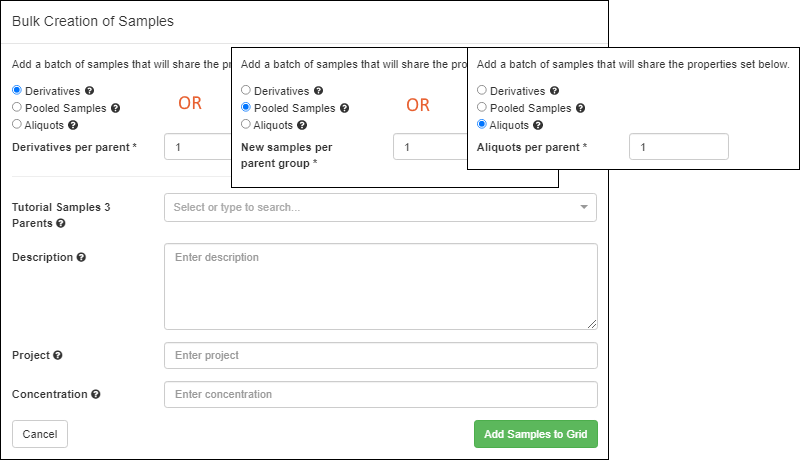
- Provide values for properties that will be shared by the newly created samples. Including 'parents' as applicable.
- Click Add Samples to Grid and continue to complete the grid with any properties not shared by all the new samples.
- Click Finish Creating ## Samples when done.
Bulk Update
While creating new samples in the grid, you can use the
Bulk Update option to assign a common value to a selected set of rows. As for
bulk update of assay data rows, you control which fields are
Enabled for update to a new common value you provide. The disabled fields will retain their original values.
Import Samples From File
Another bulk method for entering samples, particularly useful for a large group or when sample information is available in a spreadsheet already, you can import them directly from a file.
Note that fields of type
File are not included in file import methods. Values must be individually added as described in this topic:
Attach Images and Other Files.
Within the sample creation UI, click
Import Samples from File.
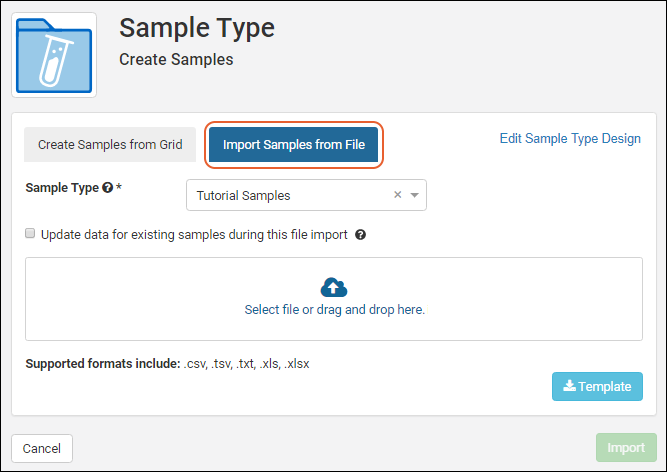
- Confirm that the Sample Type is set correctly.
- Use the Template button to download a template file showing the expected data structure for the type.
- Use this template as a guide for ensuring your data matches the expected columns.
- Note that any "File" fields will be omitted from the downloaded template.
- When populating the template, you may not need to include all columns. For example, if you have defined import aliases for sources or parents, all possible columns will be included in the template.
- A checkbox is provided to Update data for existing samples during this file import. Learn more below.
- Drag and Drop the file directly into the window to upload it.
- You will see the sample information obtained from the file in the panel.
- Only fields included in the definition of the Sample Type will be imported. In this example, the Sample ID will be generated for you, so is not included in the imported file or shown here. If any fields are unrecognized, they will be ignored and a banner will be shown.
- Note that you cannot edit the values here. If you see an error, you can use the X to delete the loaded file, make changes offline, and reselect the revised file.
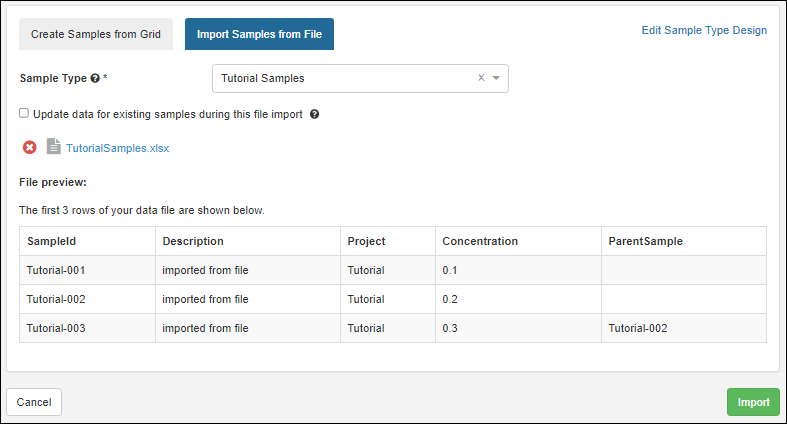
- Click Import to create the samples from the data in the file.
After creating samples, the banner message shows the number newly imported and offers the options to click to either
add them to storage now or
select them in the grid.
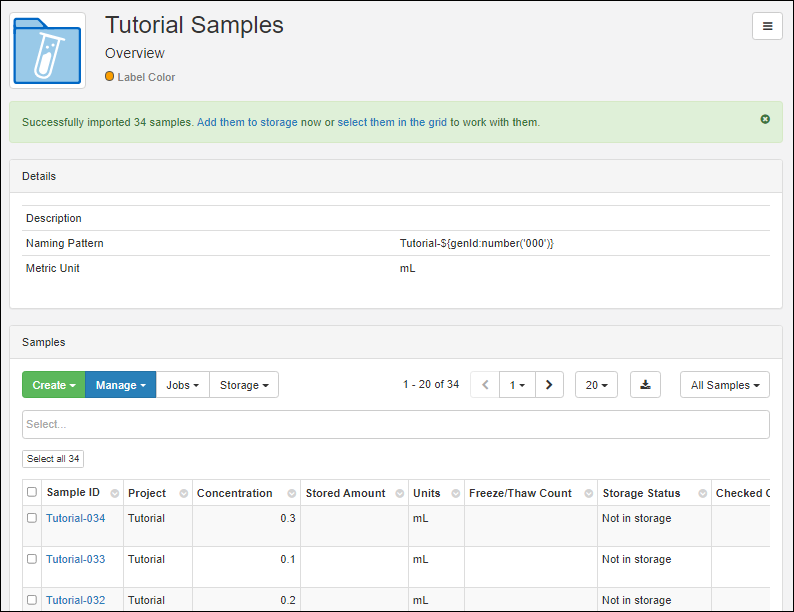
Update Existing Samples
During file import, a checkbox is provided to
Update data for existing samples during this file import.
- When checked, you can include data for samples that already exist in the system.
- Any data you provide for the rows representing samples that already exist will replace the previous values. Note that when updating, you only need to provide the columns you wish to update. Existing data for other columns will be left as is.
- If you don't check this box, the upload will be "insert only" and will fail if you attempt to import data for existing samples.
For example, you might
export an existing grid of samples, make adjustments offline or add new samples to it, and then reimport checking the update box.
Derive Samples from Parent Samples or Sources
Once you have created the Samples you want to use as parents or the Sources for some new samples, you can also create new samples from the grids for the parent or source. Creating derivatives, pooled samples, and aliquots from multiple parents are supported. Learn more in these topics:
Related Topics
